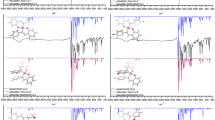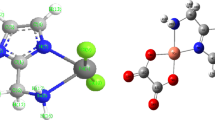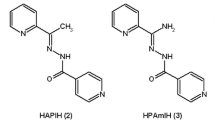Abstract
Three known organo-antimony(III)–copper(I), mixed-metal small bioactive molecules (SBAMs) of formula [Cu(tpSb)3Cl] (1), [Cu2(tpSb)4Br2] (2) and [Cu2(tpSb)4I2] (3) (tpSb = triphenylstibine) were used for the clarification of their antiproliferative activity against human breast cancer cells: MCF-7 (hormone-dependent cells) and MDA-MB-231 (hormone-independent cells). The in vitro toxicity of 1–3 was studied against normal human foetal lung fibroblast cells (MRC-5). The genotoxicity of 1–3 was determined by the presence of micronucleus. The type of the cell death caused by 1–3 was determined using cell cycle arrest. The molecular mechanism of action of 1–3 was defined by their binding affinity towards CT-DNA (calf thymus DNA) using UV spectroscopy and viscosity measurements. Docking studies depict the interactions between 1–3 and DNA. Computations were also employed in order to rationalize the activity of these compounds. This is based on the contribution of metal aromaticity in the case of compounds 2 and 3 where the short Cu···Cu distance (2.7724(6) (2) and 2.7251(11) (3) Ǻ, respectively) suggests d10–d10 interaction between metal centres.
Graphic abstract
The known small bioactive molecules of formula [Cu(tpSb)3Cl] (1), [Cu2(tpSb)4Br2] (2) and [Cu2(tpSb)4I2] (3) (tpSb = triphenylstibine) were used for the clarification of their antiproliferative activity against human breast cancer cells: MCF-7 (hormone-dependent (HD) cells) and MDA-MB-231 (hormone-independent (HI) cells).







Similar content being viewed by others
References
Harbeck N, Penault-FLlorca F, Cortes J, Gnant M, Houssami N, Poortmans P, Ruddy K, Tsang J, Cardoso F (2019) Breast cancer. Nat Rev Dis Primers 5, Article citation ID: 66. https://doi.org/10.1038/s41572-019-0111-2
Shpakovsky DB, Banti CN, Beaulieu-Houle G, Kourkoumelis N, Manoli M, Manos MJ, Tasiopoulos AJ, Hadjikakou SK, Milaeva ER, Charalabopoulos K, Bakas T, Butler IS, Hadjiliadis N (2012) Synthesis, structural characterization and in vitro inhibitory studies against human breast cancer of the bis-(2,6-di-tert-butylphenol)tin(IV) dichloride and its complexes. Dalton Trans 41:14568. https://doi.org/10.1039/C2DT31527K
Mazumdar A, Tahaney WM, Reddy Bollu L, Poage G, Hill J, Zhang Y, Mills GB, Brown PH (2019) The phosphatase PPM1A inhibits triple negative breast cancer growth by blocking cell cycle progression. npj Breast Cancer 5, Article number: 22. https://doi.org/10.1038/s41523-019-0118-6
Theodossiou TA, Ali M, Grigalavicius M, Grallert B, Dillard P, Oliver Schink K, Olsen CE, Wälchli S, Inderberg EM, Kubin A, Peng Q, Berg K (2019) Simultaneous defeat of MCF7 and MDA-MB-231 resistances by a hypericin PDT-tamoxifen hybrid therapy. npj Breast Cancer 5, Article number: 13. https://doi.org/10.1038/s41523-019-0108-8
Hero T, Bühler H, Kouam PN, Priesch-Grzeszowiak B, Lateit T, Adamietz IA (2019) The triple-negative breast cancer cell line MDA-MB 231 is specifically inhibited by the ionophore salinomycin. Anticancer Res 39:2821–2827. https://doi.org/10.21873/anticanres.13410
Ahmad Khan R., Usman M, Dhivya R, Balaji P, Alsalme A, AlLohedan H, Arjmand F, AlFarhan K, Abdulkader Akbarsha M, Marchetti F, Pettinari C, Tabassum S (2017) Heteroleptic copper(I) complexes of “scorpionate” bis-pyrazolyl carboxylate ligand with auxiliary phosphine as potential anticancer agents: an insight into cytotoxic mode. Sci Rep 7, Article number: 45229. https://doi.org/10.1038/srep45229
Komarnicka UK, Starosta R, Płotek M, de Almeida RFM, Jeżowska-Bojczuk M, Kyzioł A (2016) Copper(I) complexes with phosphine derived from sparfloxacin. Part II: a first insight into the cytotoxic action mode. Dalton Trans 45:5052–5063. https://doi.org/10.1039/C5DT04011F
Hadjikakou SK, Ozturk II, Banti CN, Kourkoumelis N, Hadjiliadis N (2015) Recent advances on antimony(III/V) compounds with potential activity against tumor cells. J Inorg Biochem 153:293–305. https://doi.org/10.1016/j.jinorgbio.2015.06.006
Banti CN, Papatriantafyllopoulou C, Manoli M, Tasiopoulos AJ, Hadjikakou SK (2016) Nimesulide silver metallodrugs, containing the mitochondriotropic, triaryl derivatives of pnictogen; Anticancer activity against human breast cancer cells. Inorg Chem 55:8681–8696. https://doi.org/10.1021/acs.inorgchem.6b01241
Chrysouli MP, Banti CN, Kourkoumelis N, Panayiotou N, Tasiopoulos AJ, Hadjikakou SK (2018) Chloro(triphenylphosphine)gold(I) a forefront reagent in gold chemistry as apoptotic agent for cancer cells. J Inorg Biochem 179:107–120. https://doi.org/10.1016/j.jinorgbio.2017.11.004
Latsis GK, Banti CN, Kourkoumelis N, Papatriantafyllopoulou C, Panagiotou N, Tasiopoulos A, Douvalis A, Kalampounias AG, Bakas T, Hadjikakou SK (2018) Poly organotin acetates against DNA with possible implementation on human breast cancer. Int J Mol Sci 19:2055–2072. https://doi.org/10.3390/ijms19072055
Gkaniatsou EI, Banti CN, Kourkoumelis N, Skoulika S, Manoli M, Tasiopoulos AJ, Hadjikakou SK (2015) Novel mixed metal Ag(I)-Sb(III)-metallotherapeutics of the NSAIDs, aspirin and salicylic acid: enhancement of their solubility and bioactivity by using the surfactant CTAB. J Inorg Biochem 150:108–119. https://doi.org/10.1016/j.jinorgbio.2015.04.014
Polychronis NM, Banti CN, Raptopoulou CP, Psycharis V, Kourkoumelis N, Hadjikakou SK (2019) Non steroidal anti-inflammatory drug (NSAIDs) in breast cancer chemotherapy; antimony(V) salicylate a DNA binder. Inorg Chim Acta 489:39–47. https://doi.org/10.1016/j.ica.2019.02.004
Banti CN, Giannoulis AD, Kourkoumelis N, Owczarzak AM, Poyraz M, Kubicki M, Charalabopoulos K, Hadjikakou SK (2012) Mixed ligand–silver(I) complexes with anti-inflammatory agents which can bind to lipoxygenase and calf-thymus DNA, modulating their function and inducing apoptosis. Metallomics 4:545–560. https://doi.org/10.1039/c2mt20039b
Banti CN, Giannoulis AD, Kourkoumelis N, Owczarzak A, Kubicki M, Hadjikakou SK (2014) Novel metallo-therapeutics of the NSAID naproxen. Interaction with intracellular components that leads the cells to apoptosis. Dalton Trans 43:6848–6863. https://doi.org/10.1039/c3dt53175a
Poyraz M, Banti CN, Kourkoumelis N, Dokorou V, Manos MJ, Simčič M, Golič-Grdadolnik S, Mavromoustakos T, Giannoulis AD, Verginadis II, Charalabopoulos K, Hadjikakou SK (2011) Synthesis, structural characterization and biological studies of novel mixed ligand Ag(I) complexes with triphenylphosphine and aspirin or salicylic acid. Inorg Chim Acta 375:114–121. https://doi.org/10.1016/j.ica.2011.04.032
Batsala GK, Dokorou V, Kourkoumelis N, Manos MJ, Tasiopoulos AJ, Mavromoustakos T, Simčič M, Golič-Grdadolnik S, Hadjikakou SK (2012) Copper(I)/(II) or silver(I) salts towards 2-mercaptopyrimidine; An exploration of a chemical variability with possible biological implications. Inorg Chim Acta 382:146–157. https://doi.org/10.1016/j.ica.2011.10.024
Bowmaker GA, Hart RD, De Silva EN, Skelton BW, White AH (1997) Lewis-base adducts of Group 11 Metal(I) compounds. LXX synthesis, spectroscopy and structural systematics of 1:2 binuclear adducts of copper(I) halides with triphenylstibine, [(Ph3Sb)2Cu(-X)2Cu(SbPh3)2], X = Cl, Br, I. Aust J Chem 50:621–626. https://doi.org/10.1071/C96036
Zhang Q-F, Zeng D-X, Xin X-Q, Wong W-T (1999) Solid state synthesis and structural characterization of binuclear Cu(I)-SbPh~3 Complex [Cu(SbPh3)2I]2. Jiegou Huaxue (Chin J Struct Chem) 18:356
Paizanos K, Charalampou D, Kourkoumelis N, Kalpogiannaki D, Hadjiarapoglou L, Spanopoulou A, Lazarou K, Manos MJ, Tasiopoulos AJ, Kubicki M, Hadjikakou SK (2012) Synthesis and structural characterization of new Cu(I) complexes with the antithyroid drug 6-n-propyl-thiouracil. Study of the Cu(I)-catalyzed intermolecular cycloaddition of iodonium ylides towards benzo[b]furans with pharmaceutical implementations. Inorg Chem 51:12248–12259. https://doi.org/10.1021/ic3014255
Rheingold AL, Fountain ME (1984) Crystal and molecular structure of [(C6H5)3Sb]3CuCl·CHCl3. J Crystallogr Spectrosc Res 14:549. https://doi.org/10.1007/BF01182141
Reichle WT (1971) Preparation, physical properties and reactions of copper(I)-triphenyl-m complexes (M = P, As, Sb). Inorg Chim Acta 5:325–332. https://doi.org/10.1016/S0020-1693(00)95939-5
Tsiatouras V, Banti CN, Grześkiewicz AM, Rossos G, Kourkoumelis N, Kubicki M, Hadjikakou SK (2016) Structural, photolysis and biological studies of novel mixed metal Cu(I)-Sb(III) mixed ligand complexes. J Photochem Photobiol B 163:261–268. https://doi.org/10.1016/j.jphotobiol.2016.08.041
PvR Schleyer, Maerker C, Dransfeld A, Jiao H, Hommes NJRvE (1996) Nucleus-independent chemical shifts: a simple and efficient aromaticity probe. J Am Chem Soc 118:6317–6318. https://doi.org/10.1021/ja960582d
Huang X, Zhai HJ, Kiran B, Wang LS (2005) Observation of d-orbital aromaticity. Angew Chem 44:7251–7254. https://doi.org/10.1002/anie.200502678
Kajstura M, Dorota Halicka H, Pryjma J, Darzynkiewicz Z (2007) Discontinuous fragmentation of nuclear DNA during apoptosis revealed by discrete “sub-G1” peaks on DNA content histograms. Cytom A 71A:125–131. https://doi.org/10.1002/cyto.a.20357
Gou Y, Qi J, Ajayi J-P, Zhang Y, Zhou Z, Wu X, Yang F, Liang H (2015) Developing anticancer copper(II) pro-drugs based on the nature of cancer cells and the human serum albumin carrier IIA subdomain. Mol Pharm 12:3597–3609. https://doi.org/10.1021/acs.molpharmaceut.5b00314
Lee S-H, Kim D-K, Seo Y-R, Woo K-M, Kim C-S, Cho M-H (1998) Nickel(II)-induced apoptosis and G2/M enrichment. Exp Mol Med 30:171–176. https://doi.org/10.1038/emm.1998.25
Kohn EA, Ruth ND, Kay Brown M, Livingstone M, Eastman A (2002) Abrogation of the S phase DNA damage checkpoint results in S phase progression or premature mitosis depending on the concentration of 7 hydroxystaurosporine and the kinetics of Cdc25C activation. J Biol Chem 277:26553–26564. https://doi.org/10.1074/jbc.M202040200
Galindo-Murillo R, Carlos Garcıa-Ramos J, Ruiz-Azuara L, Cheatham TE, Cortes-Guzman F (2015) Intercalation processes of copper complexes in DNA. Nucl Acids Res 43:5364–5376. https://doi.org/10.1093/nar/gkv467
Serment-Guerrero J, Elena Bravo-Gomez M, Lara-Rivera E, Ruiz-Azuara L (2017) Genotoxic assessment of the copper chelated compounds Casiopeinas: clues about their mechanisms of action. J Inorg Biochem 166:68–75. https://doi.org/10.1016/j.jinorgbio.2016.11.007
Banti CN, Papatriantafyllopoulou C, Tasiopoulos AJ, Hadjikakou SK (2018) New metalo-therapeutics of NSAIDs against human breast cancer cells. Eur J Med Chem 143:1687–1701. https://doi.org/10.1016/j.ejmech.2017.10.067
Kellett A, Molphy Z, Slator C, McKee V, Farrell NP (2019) Molecular methods for assessment of non-covalent metallodrug–DNA interactions. Chem Soc Rev 48:971–988. https://doi.org/10.1039/C8CS00157J
Li D-D, Tian J-L, Gu W, Liu X, Yan S-P (2010) A novel 1,2,4-triazole-based copper(II) complex: synthesis, characterization, magnetic property and nuclease activity. J Inorg Biochem 104:171–179. https://doi.org/10.1016/j.jinorgbio.2009.10.020
Boer DR, Canals A, Coll M (2009) DNA-binding drugs caught in action: the latest 3D pictures of drug-DNA complexes. Dalton Trans. https://doi.org/10.1039/b809873p
Santini C, Pellei M, Gandin V, Porchia M, Tisato F, Marzano C (2014) Advances in copper complexes as anticancer agents. Chem Rev 114:815–862. https://doi.org/10.1021/cr400135x
Wawruszak A, Luszczki JJ, Kalafut J, Okla K, Halasa M, RiveroMuller A, Stepulak A (2019) Additive pharmacological interaction between cisplatin (CDDP) and histone deacetylase inhibitors (HDIs) in MDA-MB-231 triple negative breast cancer (TNBC) cells with altered Notch1 activity—an isobolographic analysis. Int J Mol Sci 20:3663–3679. https://doi.org/10.3390/ijms20153663
Diffraction Oxford (2008) CrysAlis CCD and CrysAlis RED. Oxford Diffraction Ltd., Abingdon
Burla MC, Caliandro R, Camalli M, Carrozzini B, Cascarano GL, De Caro L, Giacovazzo C, Polidori G, Spagna R (2005) SIR2004: an improved tool for crystal structure determination and refinement. J Appl Cryst 38:381–388. https://doi.org/10.1107/S002188980403225X
Sheldrick GM (2014) SHELXL-2014/7, program for refinement of crystal structures. University of Göttingen, Göttingen
Farrugia LJ (1999) WinGX suite for small-molecule single-crystal crystallography. J Appl Cryst 32:837–838. https://doi.org/10.1107/S0021889899006020
Banti CN, Hadjikakou SK (2019) Evaluation of genotoxicity by micronucleus assay in vitro and by Allium cepa test in vivo. Bio-Protocol 9:3311. https://doi.org/10.21769/BioProtoc.3311
Frisch MJ, Trucks GW, Schlegel HB, Scuseria GE, Robb MA, Cheeseman JR, Montgomery JA Jr, Vreven T, Kudin KN, Burant JC, Millam JM, Iyengar SS, Tomasi J, Barone V, Mennucci B, Cossi M, Scalmani G, Rega N, Petersson GA, Nakatsuji H, Hada M, Ehara M, Toyota K, Fukuda R, Hasegawa J, Ishida M, Nakajima T, Honda Y, Kitao O, Nakai H, Klene M, Li X, Knox JE, Hratchian HP, Cross JB, Bakken V, Adamo C, Jaramillo J, Gomperts R, Stratmann RE, Yazyev O, Austin AJ, Cammi R, Pomelli C, Ochterski JW, Ayala PY, Morokuma K, Voth GA, Salvador P, Dannenberg JJ, Zakrzewski VG, Dapprich S, Daniels AD, Strain MC, Farkas O, Malick DK, Rabuck AD, Raghavachari K, Foresman JB, Ortiz JV, Cui Q, Baboul AG, Clifford S, Cioslowski J, Stefanov BB, Liu G, Liashenko A, Piskorz P, Komaromi I, Martin RL, Fox DJ, Keith T, Al-Laham MA, Peng CY, Nanayakkara A, Challacombe M, Gill PMW, Johnson B, Chen W, Wong MW, Gonzalez C, Pople JA (2004) Gaussian 03, Revision C.02. Gaussian, Wallingford
Rozenberg H, Rabinovich D, Frolow F, Hegde RS, Shakked Z (1998) Structural code for DNA recognition revealed in crystal structures of papillomavirus E2-DNA targets. Proc Natl Acad Sci USA 95:15194–15199. https://doi.org/10.1073/pnas.95.26.15194
Trott O, Olson AJ (2010) AutoDock Vina: Improving the speed and accuracy of docking with a new scoring function, efficient optimization, and multithreading. J Comput Chem 31:455–461. https://doi.org/10.1002/jcc.21334
Acknowledgements
This work was carried out for the fulfilment of the requirements for the B.Sc. thesis of Mr. K.K. according to the curriculum of the Department of Biological Applications and Technology of the University of Ioannina under the supervision of SKH. CNB and SKH would like to thank the Unit of Bioactivity Testing of Xenobiotics of the University of Ioannina for providing access to the facilities. CNB and SKH would like to thank the Atherothrombosis Research Centre of the University of Ioannina for providing access to the flow cytometer and to the fluorescence microscopy. This research has been co-financed by the European Union and Greek national funds through the Operational Program Competitiveness, Entrepreneurship and Innovation, under the call RESEARCH – CREATE – INNOVATE (Project Code: T1EDK-02990).
Author information
Authors and Affiliations
Corresponding authors
Ethics declarations
Conflict of interest
The authors declare that they have no conflict of interest.
Additional information
Publisher's Note
Springer Nature remains neutral with regard to jurisdictional claims in published maps and institutional affiliations.
Electronic supplementary material
Below is the link to the electronic supplementary material.
Rights and permissions
About this article
Cite this article
Banti, C.N., Tsiatouras, V., Karanicolas, K. et al. Antiproliferative activity and apoptosis induction, of organo-antimony(III)–copper(I) conjugates, against human breast cancer cells. Mol Divers 24, 1095–1106 (2020). https://doi.org/10.1007/s11030-019-10014-z
Received:
Accepted:
Published:
Issue Date:
DOI: https://doi.org/10.1007/s11030-019-10014-z




